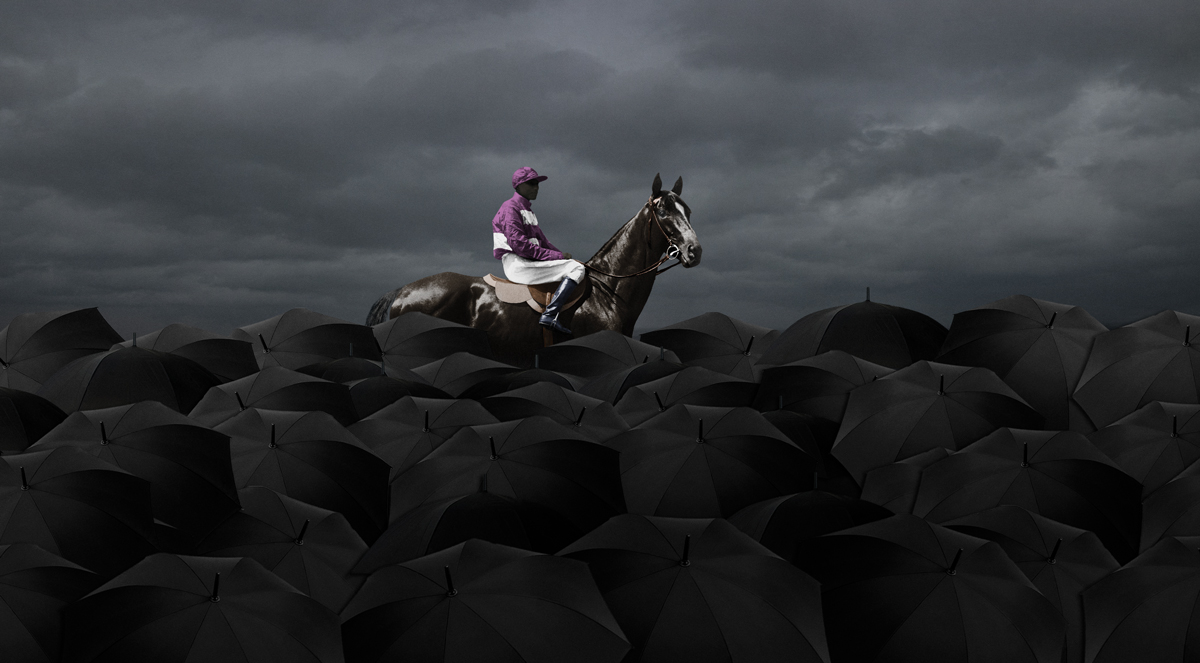
Courtesy of Bill Lowe Gallery
The photos that are available of James “Jimmy” Winkfield—a thoroughbred jockey and horse trainer from Kentucky, who was the last African American to ride a winner in the Kentucky Derby—show a young man with distinctive features: a lean stature, slight jawline, and kind eyes, the brim of a jockey cap casting a faint shadow.
In his paintings of an early-1900s Winkfield, however, artist Todd Murphy opted for a more abstract treatment: a faceless, featureless jockey to depict Winkfield’s relative obscurity in the history of the sport. While Winkfield was inducted posthumously into the National Museum of Racing and Hall of Fame in 2004, other Black jockeys—like Oliver Lewis, the first winner of the Kentucky Derby—also trained and rode with negligible fanfare or distinction.
At the Bill Lowe Gallery, director Donovan Johnson has mounted a weighty showing of Murphy’s work. The marquee exhibit, Wink—Murphy’s endearing nod to Winkfield and other Black jockeys—comprises roughly 30 paintings and mixed-media works that examine the relationship of Black identity and labor in the South through the history of African American jockeys, horse racing and the concept of the workhorse. Most of the works were created in Murphy’s last decade of life. He died in 2020.
Alongside the exhibition, the first major one since Murphy’s passing, Johnson curated an illustrated catalog chronicling Murphy’s notes, musings, and sketches from the series. Johnson also commissioned essays from art critics Seph Rodney and Peter Solomon Frank, both discussing Murphy’s place in a lineage of artists known for their works of horses and the people who wrangled them.
Murphy’s own practice was a wrangling, of sorts. Since the 1990s, after moving to Georgia from New York and studying art at the University of Georgia, he convened a wide range of mediums including sculpture, dress forms, painting, film, drawing, and photography. His earliest works were improvisations with 35-millimeter slides. He’d place one atop of another, generating colorful prisms and the illusions of depth.
“Murphy began painting on canvas, before adding plexiglass and painting with a resin that created this infinite depth behind the subject,” Johnson says. “He was building sculpture, photographing it, painting on top of that photograph, and then adding plexiglass—so it was always an extremely dynamic, layered experience.”
In Wink, Murphy sculpts and scrutinizes the horse’s anatomy, bone by bone. In the exhibit’s magnum opus, a jockey—Winkfield—and horse rise regal and heroic against a brooding sky and over a sea of umbrellas—a motif of the Kentucky Derby. The frame Murphy used, says Johnson, is a replica of the one that wraps around the Washington Crossing the Delaware painting at the Metropolitan Museum of Art in New York. The moods of the pieces—enrapturing and valiant—are intentionally identical.
“Murphy was never condescending about beauty to people who were attracted to that quality in his work. In fact, he saw it as a gateway to get them to something deeper,” says Johnson, adding that Bill Lowe, the gallery’s founder and namesake, who died in 2021, understood Murphy’s curiosities about history, myths, legends, how those are created, and how narratives are perpetuated.
“I knew that Bill always understood Murphy’s vision of the world, and I think that Murphy, in some way, knew that Bill was one of the only people who understood the grandeur of that vision.” Hence, Murphy’s slot on Johnson’s gallery schedule this year, which has been imagined as a homage to the gallery’s evolution since it was founded in 1989.
“If you talk to some of the artists who have been in Atlanta since the ’80s and ’90s, there were times where the lines were wrapped around the corner for exhibition openings, and Murphy was kind of the first art star of Atlanta since Herbert Creasy in the ’60s and ’70s,” says Johnson. “That was the power of Murphy’s first exhibitions at Lowe Gallery.”
Through the end of 2022, each show at the gallery will highlight and reengage the work of artists like Murphy, Michael David, and Jimmy O’Neal, who were cornerstones in the gallery’s history.
“Murphy’s last exhibit at the gallery was in 2001,” says Johnson, “so, it’s only right that I bring these superpowers back together.”
This article appears in our October 2022 issue.














